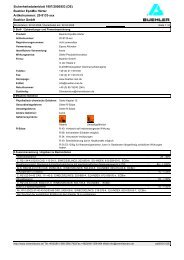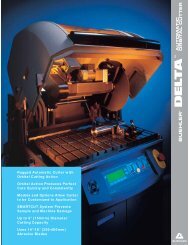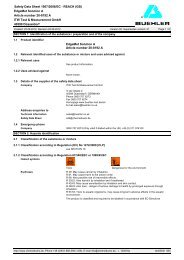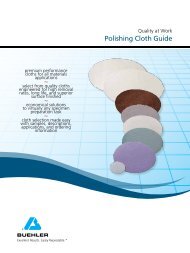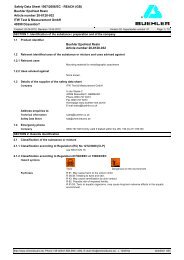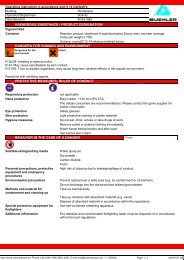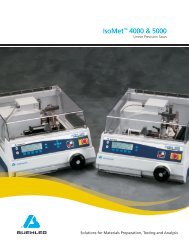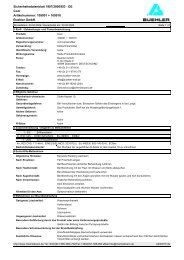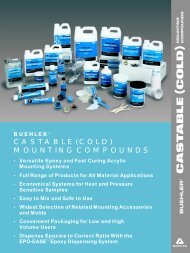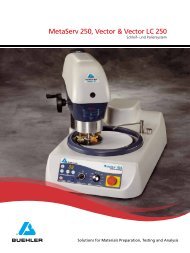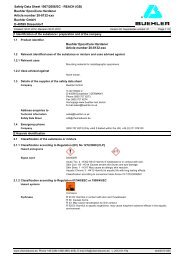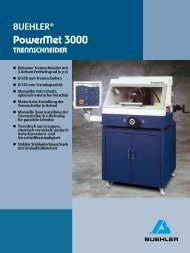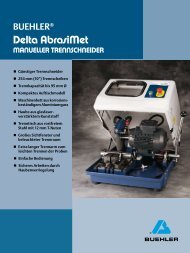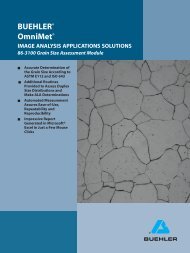BUEHLER Guide To Petrography - Department of Earth Sciences
BUEHLER Guide To Petrography - Department of Earth Sciences
BUEHLER Guide To Petrography - Department of Earth Sciences
Create successful ePaper yourself
Turn your PDF publications into a flip-book with our unique Google optimized e-Paper software.
Note, in some cases, it may be desirable to impregnate or<br />
mount the specimen first and then section it with a saw.<br />
This is done for weak, fragile or small specimens, which will<br />
otherwise break or are too small to be held securely in a<br />
chuck during sectioning.<br />
<strong>To</strong> impregnate or mount the specimen using a 20-1382<br />
Cast N’ Vac 1000, place it in a mold, such as SamplKups ® .<br />
Place the SamplKup mold and the paper cup containing<br />
epoxy in the vacuum chamber. Turn the vacuum pump on<br />
to evacuate its chamber. This draws air from pores <strong>of</strong> the<br />
specimen and facilitates filling the pores with epoxy. When<br />
a proper vacuum has been attained, tilt the epoxy cup and<br />
pour the epoxy into the mold. Keep the mold under vacuum<br />
for 3-30 second intervals slowly releasing the vacuum<br />
between them allowing air to enter the chamber forcing<br />
embedding medium into the pores.<br />
chuck, 11-2488 glass slide chuck and a 11-2481<br />
goniometer.<br />
The 20-1382 Cast N’ Vac 1000 is ideal for impregnating geological<br />
samples with a suitable bonding material that fills pores, cracks, and<br />
retards sample fracturing or plucking.<br />
A specimen should not be left under the vacuum during<br />
the curing cycle. Once the epoxy has cured, specimens can<br />
be sectioned, ground, and attached to a slide; or if a bulk<br />
specimen for reflected light microscopy has to be prepared,<br />
it can be ground and polished.<br />
Precision Sectioning/Trimming<br />
Diamond wafering saws, such as the IsoMet ® series, are<br />
ideal for precision sectioning <strong>of</strong> petrographic specimens.<br />
Cutting parameters for sectioning, which include blade<br />
speed and feed rate, can all be precisely controlled.<br />
11-1280 IsoMet ® Low Speed Saw is designed to<br />
section small specimens. Its speed is 0-300 rpm and the<br />
maximum blade size is 5″ (127mm). A precision<br />
micrometer, available with imperial or metric graduations,<br />
controls thickness <strong>of</strong> the cut. Accessories include, but are<br />
not limited to, a 11-2487 single saddle chuck,<br />
11-2486 wafer chuck, and 11-1185 irregular specimen<br />
chuck. Optional accessories include a 11-2494 bone<br />
<strong>To</strong>p) A cement sample is precisely sectioned with the 11-1280 IsoMet ®<br />
Low Speed Saw. Bottom) The 11-2488 Glass Slide Chuck for cutting<br />
glass slide mounted samples is shown.<br />
11-2180 IsoMet ® 1000 Precision Saw has a large cutting<br />
capacity with built-in inch or metric digital micrometer<br />
cross-feed for sample positioning. Its greatest speed is<br />
975rpm with a maximum blade size <strong>of</strong> 7″ (178mm). When<br />
sample size prohibits the use <strong>of</strong> standard chucks, an<br />
optional 11-2182 cutting table can be installed for<br />
manually sectioning or trimming. Accessory chucks are<br />
similar to the IsoMet Low Speed saw but have the<br />
capability <strong>of</strong> handling larger specimens.<br />
11-2680 IsoMet ® 4000 Linear Precision Saw features a<br />
SMARTCUT system which automatically monitors and<br />
adjusts the feed rate to provide consistent, quality cuts and<br />
prevents specimen and machine damage. A precision digital<br />
micrometer controls the thickness <strong>of</strong> a cut. The cutting<br />
chamber has a safety hood. A digital panel<br />
controls cutting parameters such as speed and feed rate.<br />
Maximum blade size is 8″ (203mm). The control panel is<br />
capable <strong>of</strong> displaying cutting parameters in several<br />
languages.<br />
4



